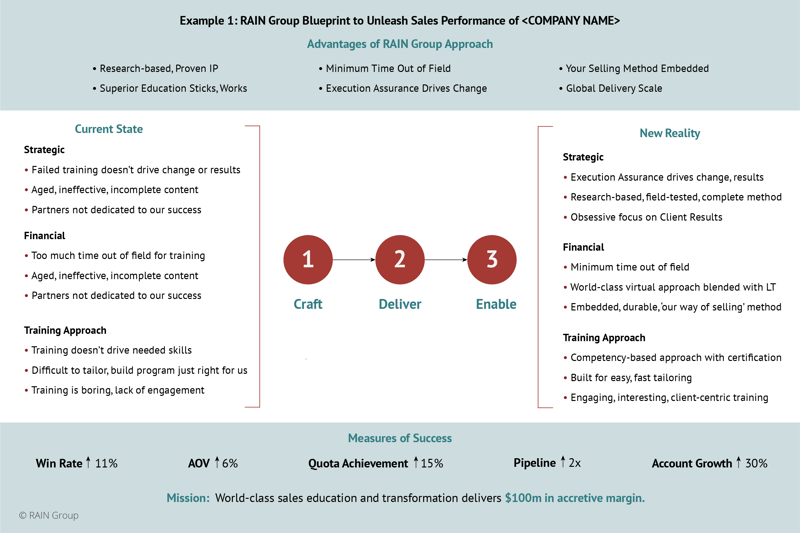Sales enablement isn't just a nice-to-have—it's a strategic imperative for driving sales success in today's dynamic business environment. Yet, many organizations struggle to implement and sustain effective sales enablement initiatives. This article explores how leveraging change management principles can transform your sales enablement strategy, leading to lasting improvements in sales performance. We'll discuss:
- The critical role of corporate culture in fostering innovation and adapting to change
- Fundamental change management practices for sales enablement initiatives
- Strategies for influencing organizational change, even without formal authority
- The importance of sales leadership in enabling transformation
- Building a culture of continuous learning for long-term sales success
By approaching sales enablement through the lens of change management, organizations can significantly boost their chances of success and create enduring impact on their sales results.
Imagine your sales team as a finely tuned racing car, ready to accelerate but stuck in first gear. This analogy reflects the reality for many companies today, where tremendous potential is hindered by ineffective sales practices and training. Recent research underscores this problem, with only 16% of sellers and sales managers rating their sales training as extremely effective.
To shift your sales team into high gear and maintain peak performance, implement sales enablement strategies through thoughtful change management.
The Role of Change Management in Sales Enablement
Before we dive into how change management can transform your sales enablement strategy, let's define what we mean by change management in this context.
What Is Change Management?
Change management is a systematic approach to moving individuals, teams, and organizations from their current state to a desired future state. It encompasses the methods and techniques used to prepare, support, and guide people through significant organizational changes to achieve strategic goals and optimize business outcomes.
With this definition in mind, let's explore how applying change management principles can transform your sales enablement initiatives and drive lasting sales success.
The Impact of Corporate Culture on Innovation and Change Management
At the core of any successful sales enablement initiative lies a critical, often overlooked factor: corporate culture. Understanding the role of corporate culture in sales enablement success will help you when it comes to implementing specific strategies.
Company Culture Definition
A company's culture encompasses the shared values, beliefs, and behaviors that shape how employees interact and work together.
Organizations with a culture that values innovation, continuous learning, and adaptability are more likely to embrace change and adopt new practices. Conversely, companies with a more rigid, hierarchical, or risk-averse culture may encounter greater resistance to change.
Research on the role of organizational culture has revealed three key insights:
- Culture Drives Innovation: An organization's culture directly influences its approach to innovation. Leaders must consider the existing cultural framework when implementing change, as it significantly impacts how new ideas and processes are received and adopted.
- Adhocracy Breeds Originality: Organizations with adhocratic cultures, characterized by flexibility, creativity, and risk-taking, are more likely to develop and adopt innovation strategies. This suggests that fostering an adhocratic culture could lead to more innovative approaches to change and problem-solving.
- Hierarchy Favors Imitation: Hierarchical cultures, which prioritize structure, control, and stability, tend to promote imitation strategies. Such organizations may resist radical changes and prefer incremental improvements based on established practices.
These findings underscore the critical role of organizational culture in determining how companies approach and implement change.
Practically speaking, this means that, to effectively navigate cultural challenges and improve the success of sales enablement initiatives, you should:
- Assess the current culture to understand existing dynamics, values, and behaviors that may impact the adoption of new sales practices.
- Align sales enablement strategies with the company's core values and mission.
- Engage influential stakeholders, such as senior leaders and top-performing sellers, to champion change and drive adoption.
- Clearly communicate the benefits of the sales enablement initiative for individual sellers, the overall team, and the organization.
- Provide ongoing support, coaching, and resources to help sellers and managers navigate the change and build confidence in the new practices.
By recognizing and addressing the interplay between culture and innovation, leaders can create environments more conducive to successful change management and growth.
Performance Research Highlights
Don’t underestimate the importance of strong sales training.
- Win rate: Respondents with extremely/very effective sales training report average win rates that are 7 to 11 percentage points higher than those with less effective training.
- Sales goal attainment: 76% of respondents with extremely effective sales training met their sales goal, compared to only 31% of those with the least effective training.
- Premium pricing: 91% of respondents with extremely effective sales training achieved premium pricing, compared to just 43% of those with the least effective training.
Practicing the Fundamentals of Change Management for Sales Enablement
Regardless of the culture you’re dealing with, change management starts with a basic principle: being dissatisfied in your current state and wanting to be in another place—what we call the New Reality.
When you take a change management approach to sales enablement, you're doing something similar to what a seller would do when making the case to a buyer to buy. In fact, making the case for change is a core skill we teach in our consultative selling and insight selling programs.

In the context of sales enablement, that means you're making the case to your sellers, sales managers, and the entire sales organization to adopt the sales approach, skills, and tools you're providing.
When making a case for a sales enablement change initiative, you need to address five key areas:
- Priorities: What aspects of sales performance need to change and why
- Approaches: How to transition from current practices to desired future state
- Impact: The expected results and urgency of implementing the change
- Decisions: Why choose this particular enablement approach over alternatives
- Partners: Who will be involved in implementing and supporting the change
Framing these five cases as a compelling narrative can bring the need for sales enablement change to life for stakeholders across the organization. Clearly illustrate the path from the current state of sales performance to the New Reality of an enabled, high-performing sales force. This clarity helps build urgency and motivation for change among leadership and the sales team alike.
A powerful tool for summarizing this case for change is a one-page "Sales Enablement Change Blueprint." This visual document outlines:
- The current state of sales performance
- The desired future state of an enabled sales force
- The proposed enablement solution and its implementation phases
- The unique advantages of this approach
- Success metrics for the initiative
- An overarching mission statement for the change
By distilling complex ideas into a clear, concise format, this blueprint makes it easier for all stakeholders to understand the value proposition and align on decisions. Even for large, complex enablement initiatives, boiling it down to one page forces clarity and focus.
The key is to maximize the organization's desire for change while minimizing perceived difficulty and risk. By clearly communicating the path forward and building belief in the potential for success, you increase the likelihood of gaining buy-in and resources for your sales enablement initiative.
Remember, the intensity with which this change is pursued depends on how much the sales team and leadership want the change, how difficult they perceive implementation to be, and their perceived risk of success or failure. As a sales leader or enablement professional, your job is to maximize desire for change, make the process as smooth as possible, and build confidence that the initiative will succeed.

What If You Don't Have a Seat at the Table?
As simple as it might be, that's what change management is all about: making sure people want to change and helping them get from their current state to their New Reality.
But, as we often hear from the folks tasked with a new sales enablement initiative, that's easier said than done.
- "My team can't change the company's sales culture."
- "L&D in my company doesn't have the authority to make change happen."
- "I'm just one person."
- "We don't have the support or resources we need."
- "We have good intentions, but change doesn't stick, and we're left with the status quo."
Shifting organizational culture in the context of sales enablement, especially without direct executive authority, presents unique challenges and opportunities.
Here are 12 tips for how you can approach this, with either a blank outline of a change blueprint or a completed draft in hand.
- Build strategic alliances:
- Identify and partner with influential leaders in sales, marketing, and product teams
- Demonstrate how improved sales enablement aligns with their goals and KPIs
- Use data to make your case:
- Collect and present data showing the impact of current sales enablement practices
- Highlight potential improvements in sales performance with cultural shifts
- Start small and demonstrate value:
- Implement pilot programs or test new approaches with a small team and track results
- Use success stories to build momentum and gain buy-in from leadership
- Leverage technology:
- Introduce tools that facilitate knowledge-sharing and collaboration among sales teams
- Use analytics to track adoption and impact of new enablement initiatives
- Create a community of practice:
- Establish a group of sales professionals and top performers who champion innovation in enablement
- Use this group to spread new ideas and practices organically
- Align with company values:
- Frame changes in terms of existing company values and mission
- Show how improved sales enablement supports broader organizational goals
- Offer continuous learning opportunities:
- Develop training curricula that focus on closing existing skills gaps and offer skill building and growth opportunities over time
- Encourage accountability and adoption by providing ongoing coaching and reinforcement
- Celebrate and share successes:
- Highlight wins and improvements resulting from new enablement approaches
- Use these stories to build credibility and support for change
- Foster cross-functional collaboration:
- Initiate projects that bring together sales, marketing, and product teams
- Use these collaborations to break down silos and promote a culture of shared success
- Personalize the approach:
- Tailor enablement strategies to individual seller's needs, such as facilitating a meeting where the seller creates their own action plans with support from a coach or manager
- Show how a more adaptive culture benefits each team member personally
- Leverage external perspectives:
- Bring in industry experts or thought leaders to share best practices
- Use external validation to support your case for cultural change
- Be patient and persistent:
- Recognize that cultural change takes time, especially without direct authority
- Consistently advocate for improvements and maintain a long-term perspective
Even without a formal "seat at the table," you can significantly influence culture through consistent, value-driven actions and by demonstrating tangible results. The key is to focus on areas where you can make an impact and gradually expand your influence as you prove the value of your approach.
Enabling a Transformation
An important step in implementing sales enablement as a change management initiative is recognizing the critical role of sales leaders and managers in driving change.
Our research shows that the best sellers are 83% more likely to have managers who effectively support them to achieve top performance. To do this, managers must be equipped with the necessary skills and tools to motivate, focus, and ensure their sellers adopt the approach.
A manager training program and a coach-the-coach process, which provides ongoing support and guidance, prepares managers to support and guide their sellers in turn. A regular, ongoing rhythm of action-oriented coaching is essential. Sales managers must provide feedback to sellers, collaborate with them, reinforce the skills and knowledge learned during training, and hold sellers accountable to execute at high levels.
Managers play a critical and too often overlooked role in enabling transformation.
Encouraging Continuous Learning for Maximum Results
Delivering a sales training curriculum isn't the end of the process. Making the shift from viewing training as discrete events to focusing on a culture of continuous learning contributes to effective sales training and enables long-term sales results.
This starts by reinforcing training after it has been completed, building seller confidence week-by-week, and monitoring progress. An ongoing schedule of coaching with access to a training resource library, tools, emailed scenarios, and embedded technology all support reinforcement efforts.
Reinforcement Research Highlights
- 70% of the information B2B sales reps learn is forgotten within a week of training.1
- 90% of new skills learned from corporate training are lost within a year.2
Consistent reinforcement post-training is essential. Research has shown that sales training can significantly impact sales performance, but only when it's effectively implemented and reinforced. Using assessments pre- and post-training, you can target any areas requiring additional training or support.
By continuously learning and adapting, sales professionals can maintain their effectiveness and consistently meet or exceed their targets.
The Impact of Change Management
Approaching sales enablement strategies through change management will significantly boost your chances of success.
Use a sales enablement change blueprint to help embed the approach into the company's DNA and to empower your sales team with the skills, resources, and mindset to excel. A cultural shift, supported by ongoing training, reinforcement, and coaching, will lead to marked improvements in sales outcomes.
Moreover, creating a culture where change and learning are embraced will ensure your sales organization can fully accelerate as needed and achieve long-term sales success, not just temporary improvements.
Culture isn't just about what you say—it's about what you do consistently.
1 Jordan Bryan, “The Evolution of Sales Training and Coaching Technology,” Gartner, September 19, 2019, https://www.gartner.com/smarterwithgartner/the-evolution-of-sales-training-and-coaching-technology.
2 Winfred Arthur Jr., et al, "Factors That Influence Skill Decay and Retention: A Quantitative Review and Analysis," Human Performance 11, 1 (1998): 57–101, DOI: 10.1207/s15327043hup1101_3.








